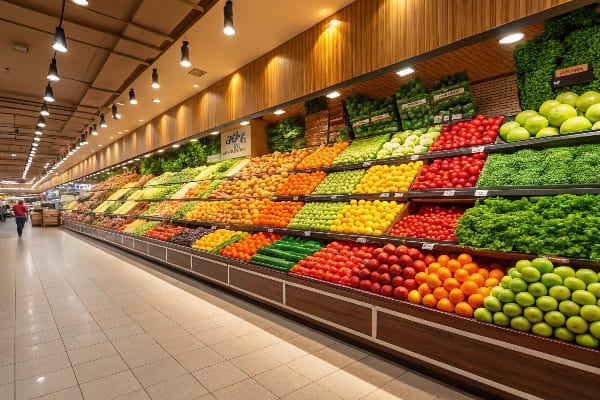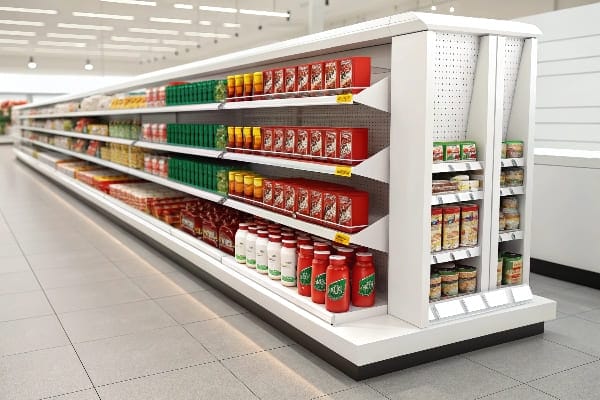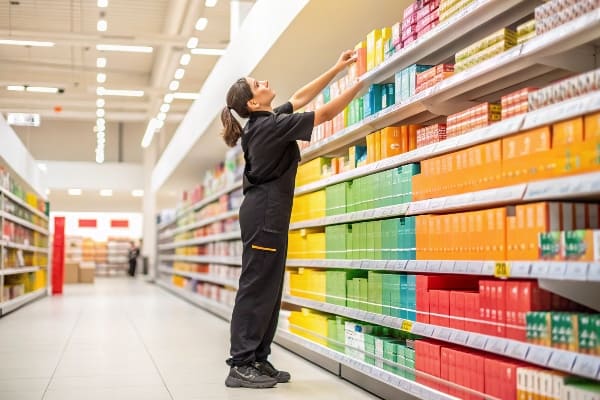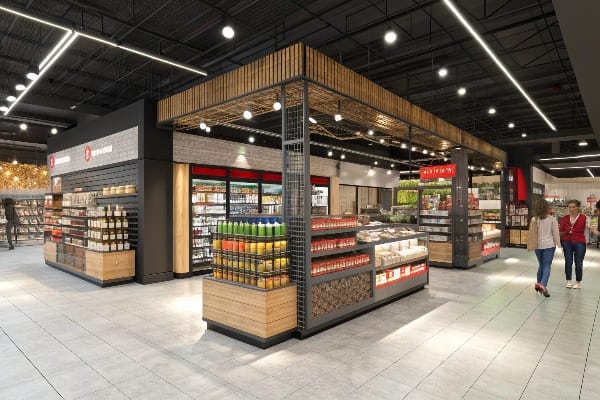Shoppers pause when a product jumps out at them; if my display fails to shout, I lose them. I need every square inch to work harder than the next aisle.
Grocery store displays and shelving are sales devices that guide traffic, lift visibility, and turn wandering eyes into paying hands.

I will break down each hot question so you see why fixtures are more than wood and steel, and how the right mix can stack extra revenue on every shelf.
What are grocery store displays called?
A cluttered mass of boxes feels like a bargain bin, yet a sharp free-standing unit sparks desire. Shoppers decide in seconds, so the fixture name shapes my design.
Grocery store displays are commonly called point-of-purchase (POP) displays.

The POP umbrella1 and its many faces
I meet buyers who mix up endcaps, shippers, and dump bins. All of them sit under the POP umbrella. POP means any in-store piece that pushes shoppers to decide while they hold a cart. The key is proximity to the product and the moment of payment. I build corrugated units because cardboard ships flat, prints bright, and saves freight.
Choosing the right POP type
| POP Style | Best Location | Primary Goal | Typical Lifespan |
|---|---|---|---|
| Endcap | Aisle ends | Spotlight seasonal items | 4–8 weeks |
| Floor Stand | Power aisle | Launch new SKUs | 8–12 weeks |
| Counter Display | Checkout | Trigger impulse buys2 | 2–6 weeks |
| Sidekick | Pegboard side | Cross-sell small add-ons | 4–8 weeks |
A new hunting-tool launch from a client in the U.S. needed fast impact. I picked a four-shelf floor stand3. We printed camo graphics, added a header shaped like a crossbow sight, and loaded 20 pounds per shelf. That single stand lifted unit sales by 38 % in the first month. The buyer called it his strongest POP trial to date.
Design starts with the offer. I outline the product promise, then build the structure around it. I test load strength, corner crush, and color rub. When the sample passes, my Guangzhou plant presses GO on high-speed die cutting. In two weeks the POPs board a container to Los Angeles, ready for in-store drop-in. That speed keeps me ahead of launch calendars.
What is grocery store shelving called?
Shelf space is retail real estate. Use the right name and the store manager listens; use the wrong one and the planogram closes.
Grocery store shelving is called gondola shelving.

Why gondolas rule the aisle
A gondola is a freestanding steel fixture4 with perforated uprights, adjustable shelves5, and a base deck. The flat sides let me clip on wire baskets, peg hooks, or cardboard wings. Because pieces bolt together, I can stretch a run or shrink it to fit a tight corner. The heavy steel base keeps tall loads stable even when kids swing on the edge.
Anatomy of efficient gondolas
| Component | Function | Material |
|---|---|---|
| Upright Post | Holds shelves | Powder-coated steel |
| Back Panel | Accepts hooks | Pegboard or slatwall |
| Base Deck | Bulk storage | Heavy gauge steel |
| Upper Shelf | Product face | Metal or wood veneer |
I have learned to measure sightline first. A middle shelf at 54 inches hits most adult eye levels. That is where I place premium SKUs. Budget items slide to the bottom. I add cardboard shelf talkers6 that pop out two inches. They are cheap, swap fast, and shout “NEW” without a reset.
One Midwest chain asked me to create cardboard sleeves that slide over existing metal. We printed harvest-green graphics to match their organic section. Installation needed no tools; a clerk slipped the sleeve on and locked it with hidden tabs. In three hours the aisle transformed, and the chain saved thousands compared to new steel.
What is it called when you stock shelves at a grocery store?
A neat shelf keeps sales smooth; a gap breaks trust. The task has its own label in retail lingo.
Stocking shelves at a grocery store is called merchandising or facing.

The art behind simple facing
Facing means pulling items forward so labels sit flush with the shelf edge. It looks basic, yet the effect is real. Shoppers read clean rows7 as freshness and abundance. When I design a cardboard tray, I leave a finger-hole notch so the clerk can pull the whole row forward in one swipe.
Steps for faster merchandising
| Step | Action | Tool |
|---|---|---|
| 1 | Pull forward | Hands or push plates |
| 2 | Fill gaps | Stock cart |
| 3 | Rotate dates | FIFO labels8 |
| 4 | Clean shelf | Microfiber cloth |
I focus on reducing labor minutes. A display that needs ten minutes to refill on Saturday morning will be skipped. That is lost sales. With a gravity-fed insert9, the clerk loads from the back; cartons glide down chute rails. I tested both flat‐shelf and gravity designs. The gravity version cut restock time by 42 %. Labor savings alone paid for the upgrade in eight weeks.
What are retail store displays?
Grocery is a subset, yet the wider retail field uses different forms and materials. I need clear language when I pitch to sports or electronics buyers.
Retail store displays are promotional fixtures that present products and messaging in the sales area.

Beyond food—materials and motives
Outside grocery, I mix MDF, acrylic, and metal. A jewelry kiosk demands glass security cases. A phone accessory spinner needs a small footprint and high hook count. The goal stays the same: convert attention into action.
Common retail display types10
| Display | Ideal Product | Typical Material |
|---|---|---|
| Spinner Rack | Keychains, cables | Wire |
| Lightbox Stand | Cosmetics | Acrylic & LED |
| Pallet Display | Bulk packs | Corrugated |
Last year a hunting-gear client needed a rugged yet lightweight stand for crossbow bolts. We laminated corrugate with matte film to cut glare, die-cut antler shapes for side panels, and added a removable header so the same base could switch graphics per season. The flexible bill of materials11 kept costs down when orders were small, yet the impact matched a full custom wooden stand.
I always include a quick assembly guide12 printed inside the master carton. Clear diagrams reduce setup calls and protect my lead times. If a store crew can pop it in place under five minutes, my repeat orders jump.
How are grocery stores organized?
A shopper may think aisles follow random whim. In truth, every shelf inch is engineered to drive flow and ticket size.
Grocery stores are organized by category adjacency, traffic flow, and profit zones mapped in a planogram.

Reading the store like a map
The entry corridor drives first impressions. Produce and bakery greet with color and smell, building a fresh image13. Staples like milk hide at the back so customers traverse impulse zones14. Endcaps highlight high-margin specials. I align my display pitch with these zones.
Example front-to-back layout
| Zone | Main Goods | Shopper Emotion |
|---|---|---|
| Front | Produce, flowers | Freshness |
| Mid-aisles | Canned, dry | Routine stock-up |
| Perimeter | Meat, dairy | Trust & quality |
| Checkout | Candy, magazines | Impulse fun |
I worked with a southern chain that moved nuts from the baking aisle to the produce entrance, right beside bananas. We rolled out a narrow cardboard stacker that matched the wood produce bins. Sales of nut packs rose 55 %. The only change was location and a fresh-looking display skin. This proves organization shapes behavior more than price tags.
When I design, I request the retailer’s planogram15 early. If my stand blocks sightlines or exits the zone map, it will be refused on arrival. A quarter-pallet footprint (24 × 20 inches) fits most grocery aisles without squeezing carts. I build it fold-flat so store teams slide several onto a U-boat cart. Quick in, quick out.
Conclusion
Focused fixtures, right names, and smart placement turn metal and board into silent sales staff.
Understanding the POP umbrella can enhance your marketing strategies and improve in-store sales effectiveness. ↩
Learning about strategies to boost impulse buys can significantly enhance your retail sales and customer engagement. ↩
Exploring the effectiveness of floor stands can provide insights into maximizing product visibility and sales. ↩
Explore this link to understand how freestanding steel fixtures can enhance retail displays and improve customer engagement. ↩
Discover how adjustable shelves can maximize space and flexibility in retail environments, making them a must-have for any store. ↩
Learn how cardboard shelf talkers can effectively promote products and increase sales without significant investment. ↩
Exploring this resource will reveal how clean rows enhance shopper perception and boost sales, making it essential for effective merchandising. ↩
Understanding FIFO labels is crucial for effective inventory management, ensuring freshness and reducing waste in retail environments. ↩
This link will provide insights into the advantages of gravity-fed systems, showcasing their impact on labor savings and restocking speed. ↩
Understanding various retail display types can enhance your merchandising strategy and boost sales. ↩
Exploring flexible bills of materials can help you optimize production costs and adapt to changing order sizes efficiently. ↩
A well-designed assembly guide can streamline setup and improve customer satisfaction, leading to repeat business. ↩
Exploring the concept of a fresh image can provide insights into effective merchandising strategies that attract customers. ↩
Understanding impulse zones can help retailers optimize store layouts for increased sales and customer engagement. ↩
Learning about planograms can enhance your understanding of effective product placement and store organization. ↩

